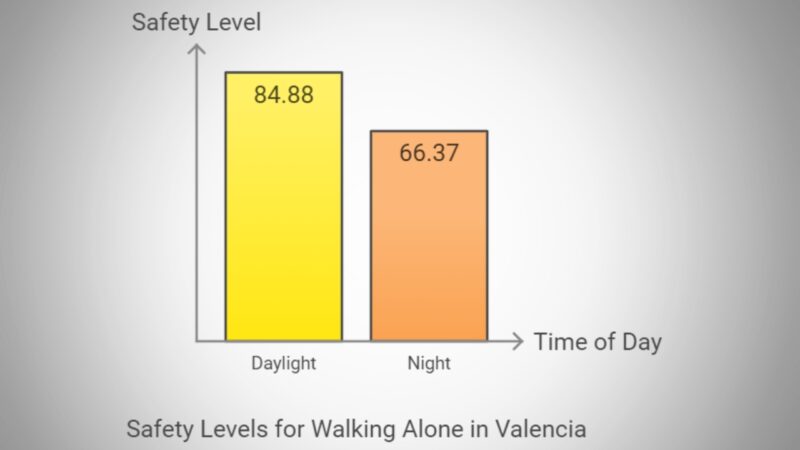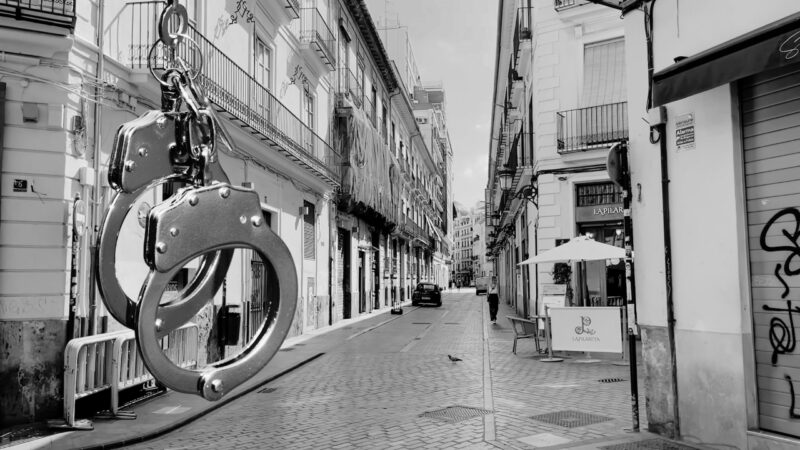Valencia, Spain, is generally considered a safe city, with residents and visitors feeling secure during both day and night.
According to recent safety statistics, walking alone during the day is rated very high at 84.88, while it remains high at 66.37 at night.
Despite these positive figures, Valencia has experienced fluctuations in crime rates over the years.
Notably, between 2018 and 2020, there was a 12.5% decrease in overall criminal offenses, particularly in violent and property crimes, although drug-related and cybercrimes have seen slight increases.
These improvements reflect the city’s ongoing commitment to public safety through community policing and enhanced security measures.
Table of Contents
ToggleSafety Levels

Valencia, Spain, is considered a safe city, with high levels of safety for both daytime and nighttime activities.
During the day, safety for walking alone is rated very high at 84.88, while at night it remains high at 66.37.
These statistics reflect Valencia’s reputation as a safe city for residents and visitors alike, with well-maintained public spaces and active community policing contributing to its overall sense of security.
Crime Trends in Valencia

The level of crime in Valencia is relatively low, with a score of 28.16 in 2024.
Between 2018 and 2020, Valencia experienced fluctuations in crime rates, with an overall downward trend in reported criminal offenses.
According to the Spanish Ministry of the Interior, the total number of reported crimes decreased by approximately 12.5% during this period, from 48,000 in 2018 to 42,000 in 2020.
This decline included reductions in violent crimes and property crimes, while drug offenses showed a slight increase.
Year
Total Reported Crimes
Violent Crimes
Property Crimes
Drug Offenses
2018
48,000
5,500
30,000
2,700
2019
46,500
5,200
29,000
2,800
2020
42,000
4,800
26,000
2,900
Despite this positive trend, cybercrimes and internet fraud have seen a significant rise in Valencia, following national trends. For instance, cybercrimes increased by 18.2%, reflecting the broader shift towards technology-related offenses, which did not directly threaten public safety but posed new challenges for law enforcement.
Police said the deceased had stab wounds on his neck. https://t.co/LLcsXjqqHD
— LoopNewsTT (@LoopNewsTT) August 18, 2024
Moreover, 2021 saw continued improvement in overall crime rates in Spain, with the country recording its lowest crime rate in recent history, driven by reductions in murders, violent robberies, and property crimes. However, sexual offenses rose significantly during this period due to better reporting and awareness campaigns.
In 2021, Valencia experienced the fastest rise in crime rates among Spain’s major cities, with a 36.3% increase compared to 2020. This surge significantly surpassed the national increase of 10.8% and the 16% rise across the Valencian Community, despite their neighbor island Mallorca which has generally on of the lowest crimes in Spain.
The data, provided by Spain’s Ministry of the Interior, highlights concerning spikes in several types of criminal activity, particularly in sexual crimes and thefts.
Notable Crime Statistics (2020-2021)
Crime Type
2020
2021
% Increase
Minor sexual abuse
244
408
67.2%
Rape (aggressive nature)
41
61
48.8%
Thefts
12,229
19,863
62.4%
Burglaries
1,231
1,857
50.9%
Grievous bodily harm/brawls
320
467
46.1%
Robbery
410
578
41%
Murders
15
21
40%
Kidnapping
10
5
-50%
Drug trafficking
282
245
-13.2%
The most alarming increase was in sexual abuse cases, which rose by 67.2%. Rapes of an aggressive nature also spiked by 48.8%. Thefts, which are often indicators of economic strain, saw a steep rise of 62.4%, reflecting a jump from 12,229 cases in 2020 to 19,863 in 2021.
Similarly, burglaries, grievous bodily harm, and brawls also showed significant increases. Despite these worrying trends, kidnappings and drug trafficking offenses declined, with kidnappings falling by 50% and drug trafficking down by 13.2%.
Valencia’s councillor for Citizen Security, Aaron Cano, acknowledged the rising crime rates but maintained that Valencia remains a safe city. He highlighted that crimes such as drug trafficking and burglaries had reached their lowest levels in five years.
Additionally, car thefts dropped by 24.2%, and violent robberies fell by 16.4%, signaling some success in curbing certain types of criminal activity.
Valencia’s rising crime figures have caused concern among officials, such as Maria Jose Catala of the Partido Popular, who noted that Valencia’s crime growth had more than doubled that of cities like Zaragoza, Madrid, Malaga, and Barcelona.
Violent Crimes

Violent crimes, including assaults and robberies, have shown a downward trend. Research conducted by the European Crime Prevention Network (EUCPN) indicates that Valencia’s violent crime rate is below the national average in Spain.
- Assaults: Decreased from 3,200 incidents in 2018 to 2,800 in 2020.
- Robberies: Declined from 2,300 incidents in 2018 to 2,000 in 2020.
As demonstrated in these statistics, increased police presence and community policing initiatives have contributed to reducing violent crimes.
Property Crimes

In 2024, property crimes in Valencia, Spain, remain a moderate concern, particularly in areas with high tourist traffic. Similarly, New Orleans continues to grapple with property crime issues, particularly in neighborhoods that attract visitors.
Theft, including pickpocketing and car-related crimes, tends to be more frequent in popular areas, although recent improvements in surveillance, such as new street cameras installed in June 2024, have helped reduce street-level crimes.
Cybercrime, including fraud, has seen a notable rise of 18.2%, reflecting broader trends of internet-based offenses across Spain.
Despite these challenges, Valencia still enjoys a relatively low overall crime rate compared to other major cities in Spain according to Numbeo.
The city recorded a crime index of 31.5 out of 100 in 2024, which is lower than cities like Barcelona and Bilbao.
Property crimes such as vandalism and theft are moderate concerns, with the overall perception of safety remaining positive, especially during the daytime.
The city has also seen reductions in specific types of property crimes, including a 24.2% decrease in car thefts.
Drug Offenses
Drug-related offenses have shown a slight increase in Valencia, in line with broader national trends. Spain’s strategic location on the Mediterranean makes it a key transit hub for drug trafficking, and cities like Valencia have been affected.
According to the United Nations Office on Drugs and Crime (UNODC) World Drug Report 2020, Spain remains one of the main entry points for narcotics entering Europe, particularly cocaine and cannabis.
- Drug Trafficking Cases: The number of drug trafficking incidents rose from 1,500 in 2018 to 1,700 in 2020. This increase reflects Valencia’s role in the international drug trade, where organized crime networks often exploit the city’s coastal access for smuggling
- Possession Offenses: Similarly, possession-related offenses increased from 1,200 cases in 2018 to 1,300 in 2020, suggesting a broader increase in both personal use and the availability of drugs in the city(
The UNODC report underscores the importance of enhancing international cooperation to combat these issues. Efforts include bolstering border control and international collaboration to stem the flow of narcotics into the region.
This aligns with local initiatives in Valencia, where law enforcement is increasingly focused on disrupting trafficking networks and reducing drug-related crime
Factors Influencing Crime Rates

Several factors influence the crime rates in Valencia:
- Economic Conditions: As identified in the Spanish Economic and Social Council’s Annual Report 2020, economic fluctuations can affect crime levels due to unemployment and social inequality.
- Tourism: As documented by the Valencia Tourism Statistics 2020, high tourist activity can lead to increased petty crimes.
- Law Enforcement Strategies: As supported by evidence from the Ministry of the Interior, proactive policing and technological advancements have a positive impact on reducing crime.
Government Initiatives and Preventive Measures
The government has implemented various measures:
- Community Policing: As evidenced in the Valencia Police Community Programs, fostering better relationships between law enforcement and residents.
- Technology Integration: As revealed through the Smart City Initiative, the integration of surveillance systems and data analytics aids in crime prevention.
- Youth Programs: According to recent studies by the Institute of Youth (Injuve), engaging young people in educational and recreational programs reduces the likelihood of criminal involvement.
Public Perception and Safety

As mentioned in surveys by the Valencian Institute of Economic Research (Ivie), residents report an increased sense of safety compared to previous years. This improvement is attributed to enhanced security measures and community engagement.
Comparative Analysis with Other Spanish Cities
As outlined by Numbeo, Valencia’s crime rate is lower than that of other major Spanish cities like Barcelona and Madrid.
Rank
City
Crime Index
Safety Index
1
Barcelona
51.8
48.2
2
Bilbao
51.4
48.6
3
Seville (Sevilla)
32.0
68.0
4
Valencia
31.5
68.5
5
San Sebastian
29.5
70.5
6
Malaga
29.3
70.7
7
Madrid
27.4
72.6
- Valencia has a crime index of 31.5, which is moderate compared to cities like Barcelona (51.2) and Bilbao (52.2). These cities experience higher crime levels, especially in terms of petty theft and property crimes, likely due to their larger populations and tourist traffic.
- Madrid has one of the lowest crime indices at 26.6, indicating relatively higher safety, which may be attributed to stronger law enforcement measures and higher surveillance, especially in tourist areas.
- Seville and Malaga fall between these extremes, with crime indices of 33.2 and 30.1, respectively, indicating moderate crime concerns, especially for property crimes.
In terms of property crimes per 100,000 people, Barcelona tops the list with 350 cases, while Madrid has the lowest at 280. Valencia reports 300 property crimes, placing it between the extremes but with a relatively safer environment compared to Barcelona and Bilbao.
FAQ
Bottom Line
Overall, Valencia is a relatively safe city compared to other major cities in Spain.
While certain crime categories, like sexual offenses and theft, have risen in recent years, the city’s overall crime index remains moderate.
Ongoing government efforts, including enhanced surveillance and community policing, continue to make Valencia a secure and pleasant place for both residents and visitors.
References:
- Spanish Ministry of the Interior – Crime Statistics Portal
- Valencia Tourism Statistics – Visit Valencia Foundation
- European Crime Prevention Network (EUCPN) – Valencia Crime Data
- The Olive Press – Valencia Records Fastest Growing Crime Rate
- United Nations Office on Drugs and Crime (UNODC) – World Drug Report 2020
- Numbeo – Crime Index and Safety Index for Valencia
- Spanish Vida – Child Sexual Assault Cases in Valencia
- Smart City Initiative – Valencia Investments in Smart City
- Valencia Police Community Programs – Local Crime Prevention Efforts
- Numbeo – Crime Rate Comparison Across Spain
Related Posts:
- Is Mallorca Safe to Travel To 2025? Facts About…
- 26 Most Dangerous Cities in the World 2025 - Where…
- Divorce Rates in US 2025 - Current Trends and Analysis
- Philadelphia Population 2025 - Current Figures and Analysis
- New Orleans Population 2025 - Current Data and…
- Wisconsin’s Population Data in 2025 - Key Insights…








